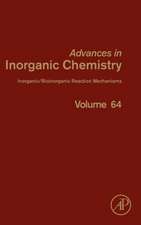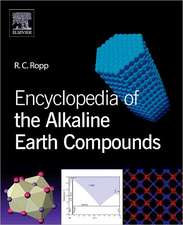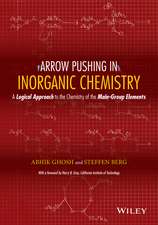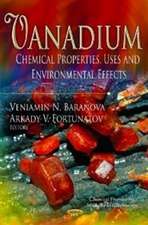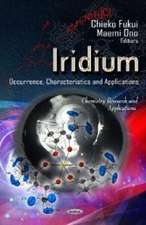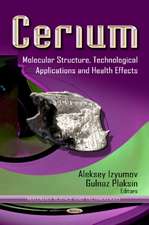The Defect Chemistry of Metal Oxides: Monographs on the Physics and Chemistry of Materials
Autor Donald M. Smythen Limba Engleză Hardback – 2 aug 2000
behavior of materials. Topics discussed include lattice and electronic defects, doping effects, nonstoichiometry, and mass and charge transport. The text distinctly emphasizes the correlation between the general chemical properties of the constituent elements and the defect chemistry and transport
properties of their compounds. It covers the types of defects formed, the effects of dopants, the amount and direction of nonstoichiometry, the depths of acceptor and donor levels, and more. Concluding chapters present up-to-date and detailed analyses of three systems: titanium dioxide, cobalt oxide
and nickel oxide, and barium titanate. The Defect Chemistry of Metal Oxides is the only book of its kind that incorporates sample problems for students to solve. Suitable for a variety of courses in materials science and engineering, chemistry, and geochemistry, it also serves as a valuable
reference for researchers and instructors.
Din seria Monographs on the Physics and Chemistry of Materials
- 15%
 Preț: 601.15 lei
Preț: 601.15 lei - 23%
 Preț: 1183.25 lei
Preț: 1183.25 lei - 20%
 Preț: 322.21 lei
Preț: 322.21 lei - 33%
 Preț: 560.35 lei
Preț: 560.35 lei - 34%
 Preț: 629.69 lei
Preț: 629.69 lei - 28%
 Preț: 465.18 lei
Preț: 465.18 lei - 31%
 Preț: 470.54 lei
Preț: 470.54 lei - 34%
 Preț: 1210.94 lei
Preț: 1210.94 lei - 34%
 Preț: 1303.47 lei
Preț: 1303.47 lei - 34%
 Preț: 1148.49 lei
Preț: 1148.49 lei - 34%
 Preț: 1819.74 lei
Preț: 1819.74 lei - 34%
 Preț: 1147.17 lei
Preț: 1147.17 lei - 22%
 Preț: 289.36 lei
Preț: 289.36 lei - 23%
 Preț: 672.48 lei
Preț: 672.48 lei - 27%
 Preț: 502.75 lei
Preț: 502.75 lei - 29%
 Preț: 591.27 lei
Preț: 591.27 lei - 34%
 Preț: 959.47 lei
Preț: 959.47 lei - 34%
 Preț: 1142.00 lei
Preț: 1142.00 lei - 27%
 Preț: 387.19 lei
Preț: 387.19 lei - 30%
 Preț: 836.08 lei
Preț: 836.08 lei - 30%
 Preț: 734.69 lei
Preț: 734.69 lei - 30%
 Preț: 812.32 lei
Preț: 812.32 lei
Preț: 1474.96 lei
Preț vechi: 2020.48 lei
-27% Nou
Puncte Express: 2212
Preț estimativ în valută:
282.23€ • 294.67$ • 233.58£
282.23€ • 294.67$ • 233.58£
Carte tipărită la comandă
Livrare economică 04-18 aprilie
Preluare comenzi: 021 569.72.76
Specificații
ISBN-13: 9780195110142
ISBN-10: 0195110145
Pagini: 304
Ilustrații: line illustrations and graphs
Dimensiuni: 157 x 242 x 20 mm
Greutate: 0.72 kg
Editura: Oxford University Press
Colecția OUP USA
Seria Monographs on the Physics and Chemistry of Materials
Locul publicării:New York, United States
ISBN-10: 0195110145
Pagini: 304
Ilustrații: line illustrations and graphs
Dimensiuni: 157 x 242 x 20 mm
Greutate: 0.72 kg
Editura: Oxford University Press
Colecția OUP USA
Seria Monographs on the Physics and Chemistry of Materials
Locul publicării:New York, United States
Descriere
This book is designed to help those with little or no background in the field of defect chemistry to apply its principles and to interpret the related behaviour of materials. It is the product of a course for advanced undergraduates and graduate students that the author taught at Lehigh University for over twenty years. The course is highly interdisciplinary and has been attended by students from the departments of chemical engineering, chemistry, electricalengineering, computer science, geology, materials science and engineering, and physics. The book is intended for use either as a text on such a course, or as a reference work that covers the major principles of defect chemistry.

